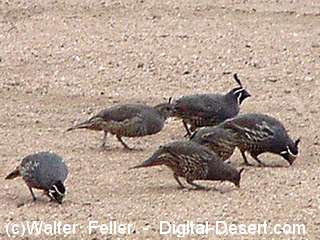|
|
Desert Wildlife >
Birds:
California Quail
Callipepla californica
Family: Odontophoridae Order: Galliformes Class: Aves
DISTRIBUTION, ABUNDANCE, AND SEASONALITY
Common, permanent resident of low and middle elevations the length of California.
Replaced by Gambel's quail in southeastern deserts. Found in shrub, scrub, and brush, open
stages of conifer and deciduous habitats, and margins of grasslands and croplands (Leopold
1977).
SPECIFIC HABITAT REQUIREMENTS
Feeding: Feeds primarily on legume and other seeds; also on green vegetation,
arthropods, grains,
and fruits. Forages on ground and low vegetation. Scratches, gleans,
grazes, and browses; jumps to pick seeds, blossoms, and fruits. Searches and pounces on
arthropods; rarely flycatches. Seldom ventures more than 15-30 m (50-100 ft) from cover to
feed. Chick eats large amounts of arthropods.
Cover: Brush and trees provide cover for feeding, escape, movement, and roosting.
Reproduction: Nests in a small depression in ground, lined with grasses and forbs; nest
hidden in herbage among shrubs.
Water: In cool weather, probably can meet water needs from succulent plants, arthropods,
and dew. In hot weather, requires free water daily. Able to use mildly salty water (Brush
1965). Gathers near water in dry weather, and disperses when green vegetation and water
are abundant.
Pattern: Requires a mosaic of low, brushy vegetation, with grass/forb openings, taller
shrubs, and trees, interspersed with water.
SPECIES LIFE HISTORY
Activity Patterns: Yearlong, diurnal activity.
Seasonal Movements/Migration: Not migratory. Winter movements usually encompass
twice the area used in summer. Covey may disperse in spring up to 8 km (5 mi).
Home Range: In California, winter home range of 4 coveys averaged 10.5 ha (26 ac), and
varied from 6.9 to 18 ha (17-45 ac). Pairs foraged daily over 4.9 to 10 ha (12-25 ac) before
incubation, and 1.2 to 4 ha (3-10 ac) during incubation. Broods used only a few acres the first
2 wk, and 4-8 ha (10-20 ac) by 1 mo. Occasionally a brood moved 1.6 km (1 mi) from nest to
brood range. In nesting season, unmated individuals may wander.
Territory: Includes the immediate vicinity of female (Sumner 1935, Genelly 1955).
Unmated male may establish a calling territory adjacent to a breeding pair.
Reproduction: Forms pairs from March to early May; nests April to August, with peak in
May and June. Clutch averages 14 eggs (range 6-16). Most nests hatch in June after
incubation of 23 days (Johnsgard 1973). Female incubates while male remains nearby. In
favorable years, female may renest while male cares for first brood (Francis 1970). Young
precocial; brood remains together through winter, or joins others.
Niche:
Predators
include
Cooper's
and sharp shinned hawks,
great horned owls, many
snakes,
ground squirrels,
domestic cats,
coyotes,
skunks,
bobcats, and
jays (Sumner 1935,
Glading 1938). Numbers and breeding success greatly affected by rainfall; high numbers
usually follow years with high winter rainfall and abundant forb crops (McMillan 1964, Francis
1970, Leopold et al. 1976). Raitt and Genelly (1964) found productivity correlated with a
minimum of fog and rain during nesting period in Alameda Co. Francis (1970) suggested that
productivity was a function of 3 variables, in decreasing order of importance: (1) high soil
moisture in late April, (2) proportion of breeding females over 1 yr old, and (3) abundant
seasonal rainfall September to April.
REFERENCES
Brush, A. H. 1965. Energetics, temperature regulation and circulation in resting, active, and
defeathered California quail, Lophortyx californicus. Comp. Biochem. Physiol. 15:399-421.
Emlen, J. T., Jr. 1939. Seasonal movements of a low-density valley quail population. J.
Wildl. Manage. 3:118-130.
Francis, W. J. 1970. The influence of weather on population fluctuation in California quail.
J. Wildl. Manage. 34:249-266.
Genelly, R. E. 1955. Annual cycle in a population of California quail. Condor 57:263-285.
Glading, B. 1938. Studies on the nesting cycle of the California valley quail in 1937. Calif.
Fish and Game 24:318-340.
Grenfell, W. E., B. M. Browning, and W. E. Stienecker. 1980. Food habits of California
upland game birds. Calif. Dep. Fish and Game, Sacramento. Wildl. Manage. Br. Admin.
Rep. No. 80-1. 130pp.
Grinnell, J., and A. H. Miller. 1944. The distribution of the birds of California. Pac. Coast
Avifauna No. 27. 608pp.
Johnsgard, P. A. 1973. Grouse and quails of North America. Univ. Nebraska Press,
Lincoln. 553pp.
Leopold, A. S. 1977. The California quail. Univ. California Press. Berkeley. 281pp.
Leopold, A. S., M. Erwin, J. Oh, and B. Browning. 1976. Phytoestrogens: Adverse effects on
reproduction in California quail. Sci. 191:98-100.
McMillan, I. I. 1964. Annual population changes in California quail. J. Wildl. Manage.
28:702-711.
Raitt, R. J., and R. E. Genelly. 1964. Dynamics of a population of California quail. J. Wildl.
Manage. 28:127-141.
Sumner, E. L., Jr. 1935. A life history of the California quail, with recommendations for its
conservation and management. Calif. Fish and Game 21:167-256;275-342.ric., For. Serv.,
Reg. 6, Portland OR. 382pp.
California Department of Fish and Game. California Interagency
Wildlife Task Group. 2005. California Wildlife Habitat Relationships version 8.1 personal computer program. Sacramento, California.
|

California Quail
Also see >
Bird:
Prey:
Herbivore:
Diurnal
Habitat:
Desert Wash
Identification Tips:
Length: 8 inches
Small, chunky, short-tailed, round-winged ground-dwelling bird
Immature similar to female
Adult male:
Black, forward-tilting, teardrop-shaped crest
Pale buff forehead
Dark brown cap
Black face
White border to face
Blackish nape stippled with white spotting
Dark blue-gray chest
Brown back and upperwings
Buff belly with darker scaly markings and chestnut center
Brown flanks with white streaks
Adult female:
Short, curved, dark brown, teardrop-shaped crest
Gray or brown head, chest, back, and upperwings
Chestnut flanks with white streaks
Pale belly with darker scaly markings
Similar species:
Mountain Quail has chestnut face, unscaled belly, and gray crown. Gambel's Quail lacks pale forehead, stippled nape and scaly belly.
Patuxent Bird Identification
The Desert Food Chain *
Everything has its niche. Who eats what, and what eats who in the desert?
Click here
to find out what more.
|
|
